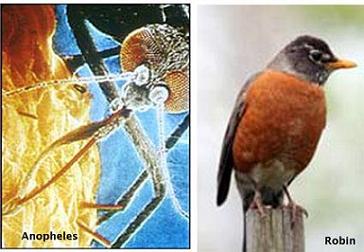
dichloro-diphenyl-trichloroethane or D.D.T. It is considered one of the most dangerous poisons because of its bad effect on living systems in both the natural environment and the human environment.
The effect accumulates and increases due to the accumulation of the poison in the (fatty) cells of anyone who comes in direct or secondary contact with the poison, mainly as a result of eating those who are directly affected by the poison. When insects that died as a result of direct contact with the poison are eaten by birds, the concentration of the poison in the birds' bodies is higher than it was In the case of the insects in the body of the one who devours/eats the birds, the concentration will be higher and so on, that is, the super predators will "accumulate" large and increasing amounts/concentrations of the poison in their bodies.
Red-breasted thrush (robin) is considered one of the most talented and therefore popular "singers" among North American birds. In a study that examined the population of red-breasted thrushes in the USA, it became clear that even today - the effect of the poison continues: the thrushes lose many eggs. The young that hatch from eggs with signs of poison do not know how to build their nest and above all that stands out and sounds good. .. is the fact that the carriers of the poison are unable to sing!
Man is at the top of the predator ladder in the food chain and as such his body will have the highest poison concentrations. All of this has been known and known to "poisoners" of all kinds for about forty years, and therefore the D.D.T. was also issued. from use. The hope was that after the distribution of the poison was stopped, after some time, its deadly effect would disappear.
At least that's what we thought and that was accepted all over the world. And not her.
About a year and a half ago I wrote about malaria and the great difficulty in finding a vaccine and an equally great difficulty in exterminating the malaria carrier - the Anopheles mosquito. It turns out that the developers of the drugs to prevent malaria are not keeping up with the rate at which the parasite develops resistance to the drugs and the race will continue. As for the race to eradicate Anopheles... the exterminators have been left far behind. The only area in which malaria prevention can be guaranteed is: prevention of bites, that is, the use of insect repellents, nets and nets that have been treated (soaked) with insect repellents.
It turns out that the cost of using insect repellents, repellents, etc., is expensive and impractical for the majority of the population who are at constant risk (of being stung). Therefore, the health authorities are pressuring governments to use the most effective means of pest control known... to return to the use of DDT! Use, that is: Spraying of buildings (internal spraying on the walls, doors, ceilings, beds and everything inside the houses), spraying of water bodies and moist areas where mosquitoes breed and develop. In other words, back to the period (30s to 70s) when quantities of poison were poured without recognition!
The health authorities in Uganda, Kenya, Tanzania and following them in many countries across the continent press for the use of the poison despite the opposition of green organizations and despite the existence of an international treaty that prohibits the production of DDT and the use of the poison. It turns out that many countries have poison reserves. Irresponsible, uncomprehending bodies (lacking morals) come to the dumps and distribute the poison in the "black market". This is how a situation is created where in areas where there is no close supervision by the authorities, the poison is distributed and spread without diagnosis!
In the meantime, the long-term effects of the poison are becoming clear: in a study conducted at the University of Berkeley in California and published in the "Pediatrics" pen, the findings were published: DDT in living tissues (or plants) changes its composition if time into two toxic compounds dichlorodiphenyldichloroethane DDD, and dichlorodiphenyldichloroethylene DDE has similar physical and chemical properties to DDT. 33 years after the cessation of the use of DDT, its traces can be found in 10% of the US population! Whereas its sub-compounds can be found in the entire population!
In Mexico, where the use was banned only in 2000, it became clear that the presence of DDT in the tissues of pregnant women causes "premature birth"; Lactating women "feed" their babies with poison; The higher the exposure to the poison in the womb, the slower the development of the embryos; At the age of 6 to 12 months, a delay was diagnosed in the physical and mental development of the children. - In the first brood, more poison accumulates than in his younger brothers; - The parallel finding that breastfeeding reduces the risk of breast cancer is ironic...
The researchers intend to continue monitoring the children's development in the coming years, but the current findings show how dangerous the poison is, that is: even after years when it was not added to the environment, its negative effect continues and is harmful.
Now we can only hope that the authorities in African countries will know how to manage their steps while thinking that they will weigh all the data....?
